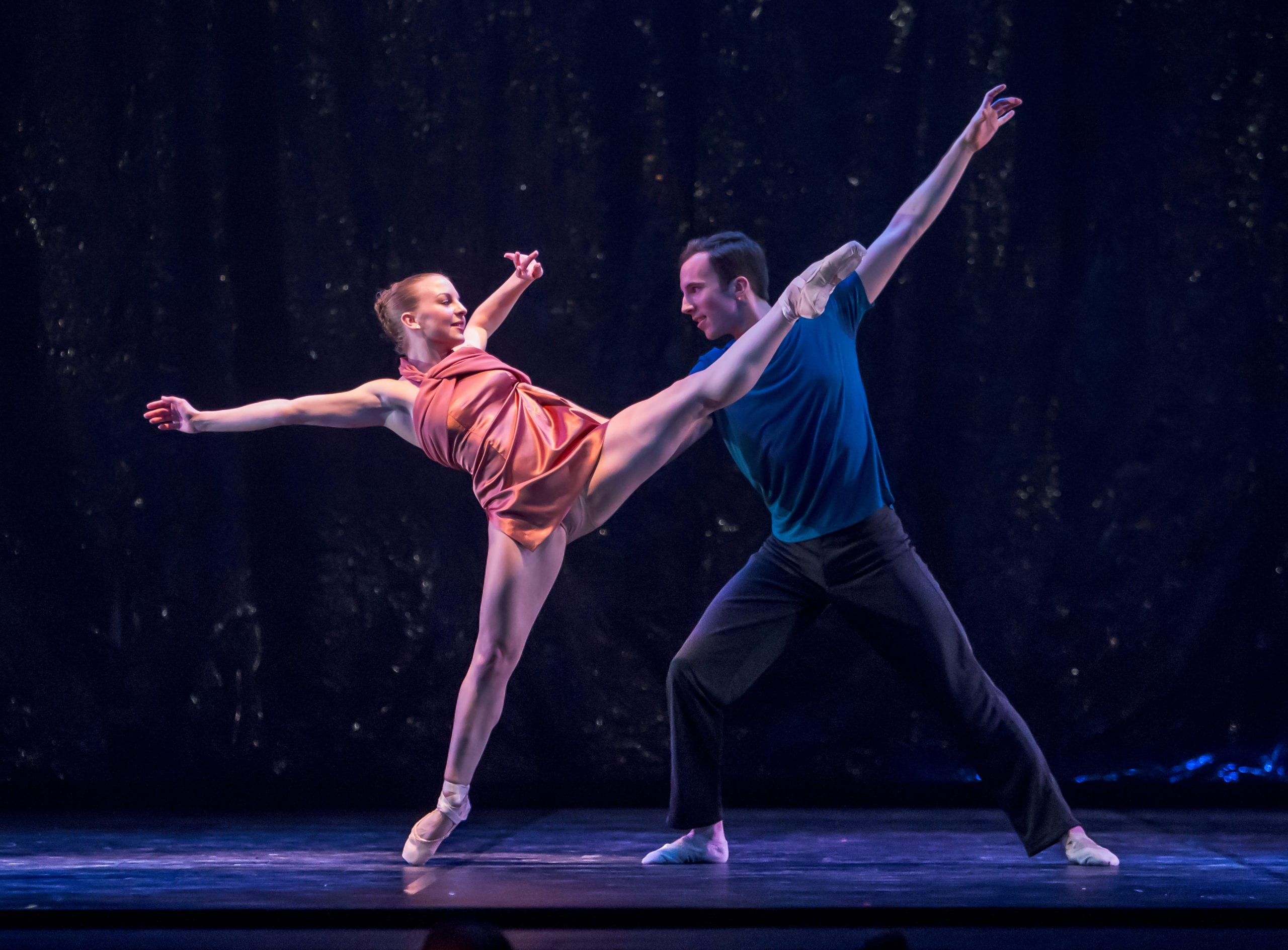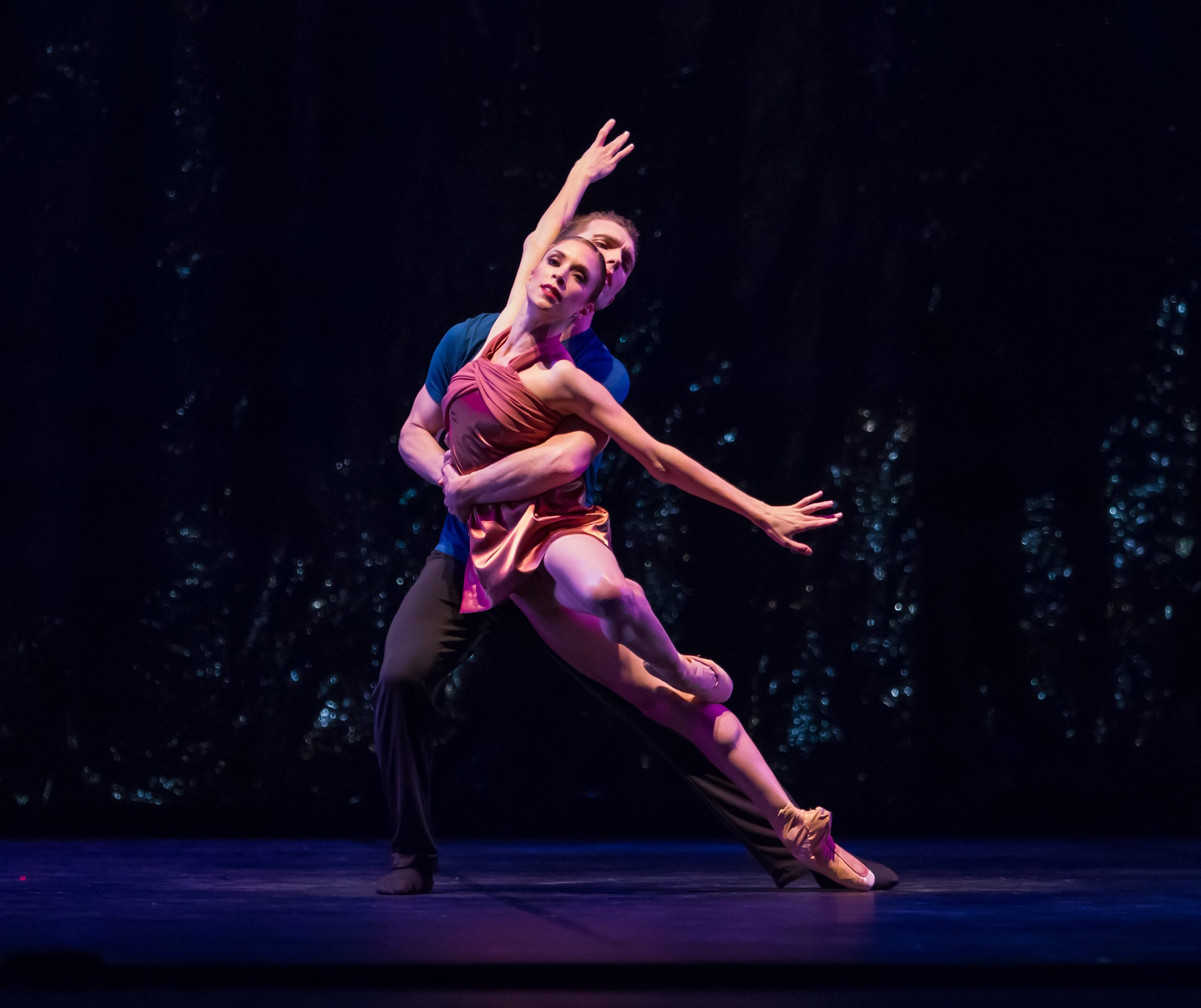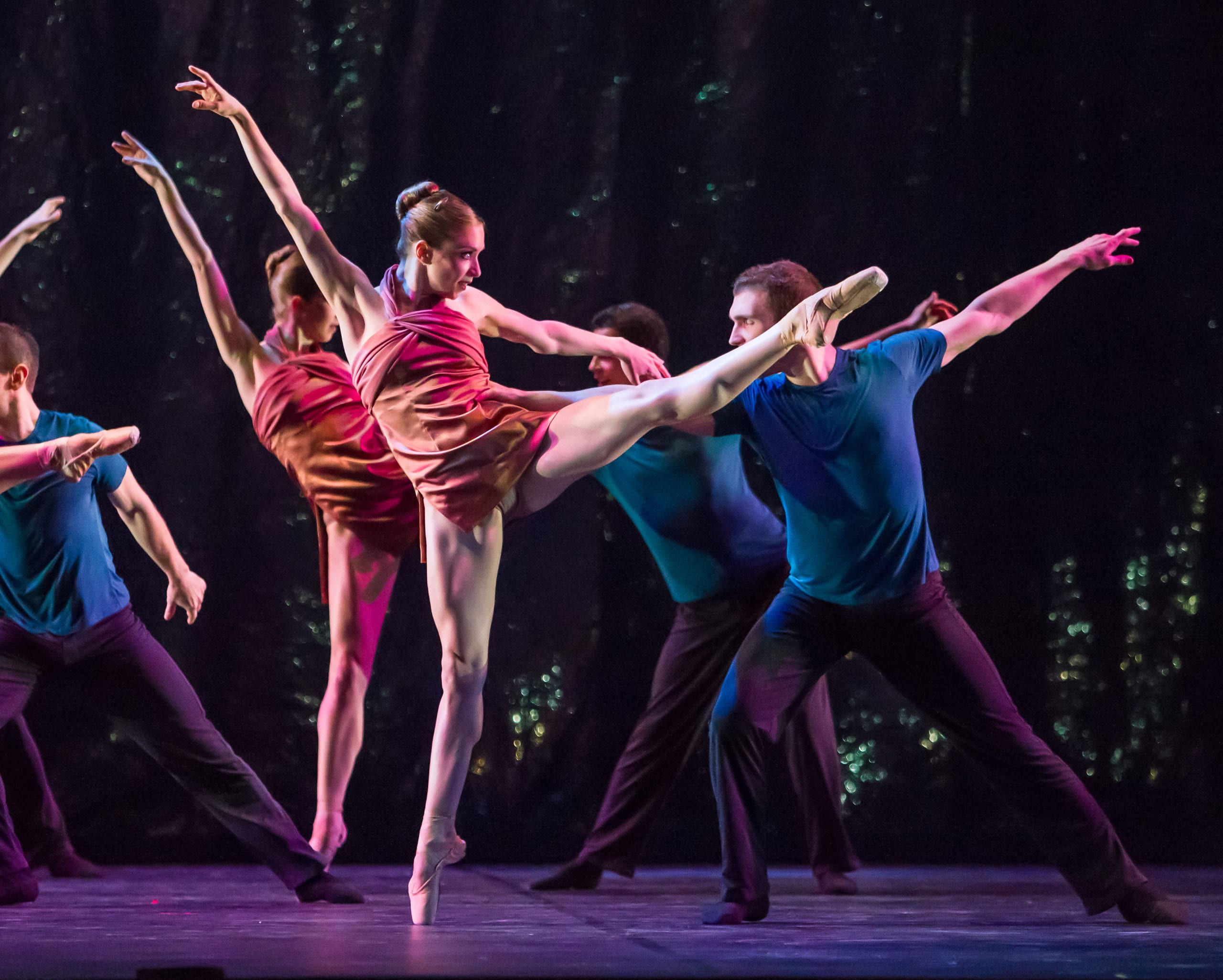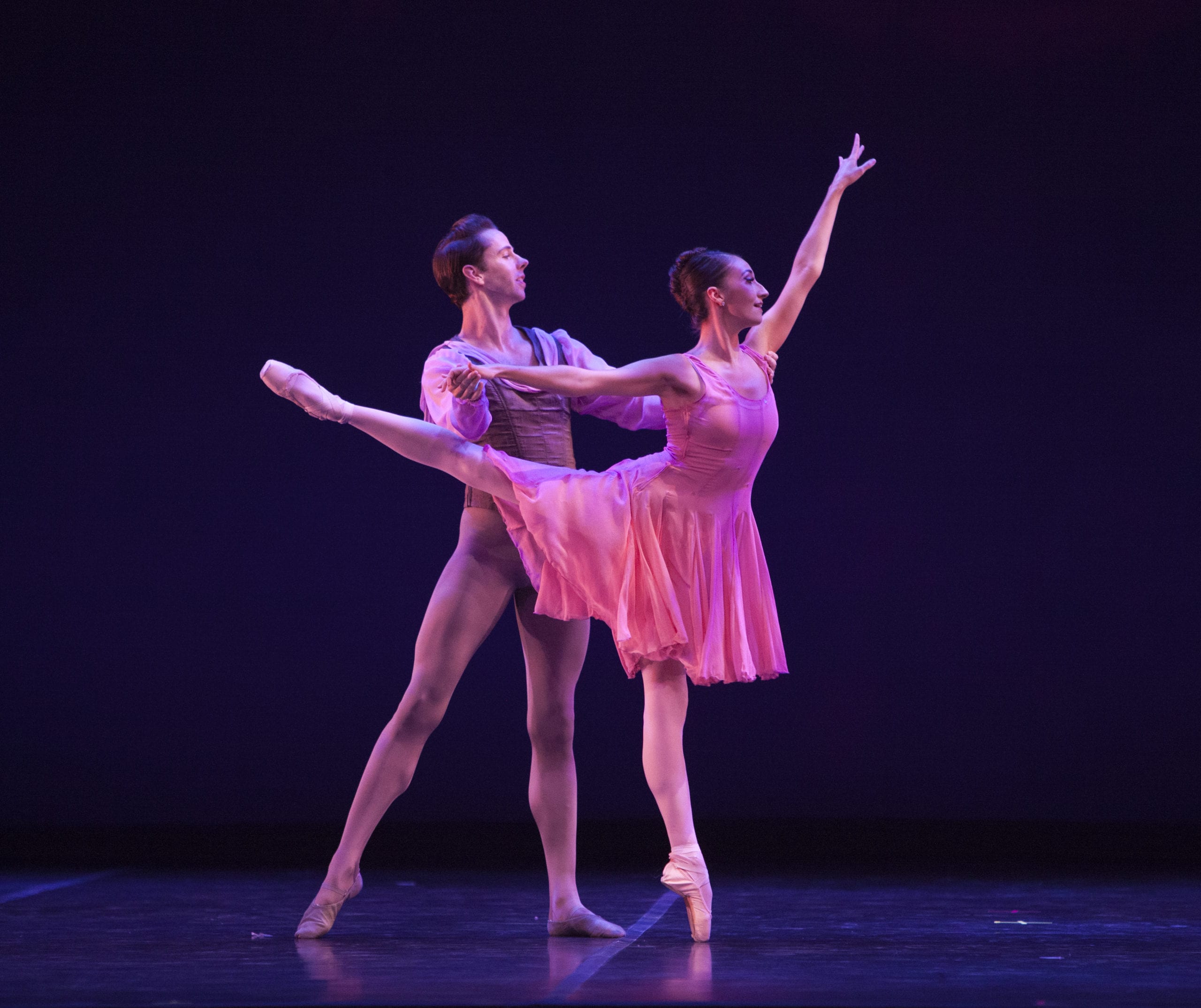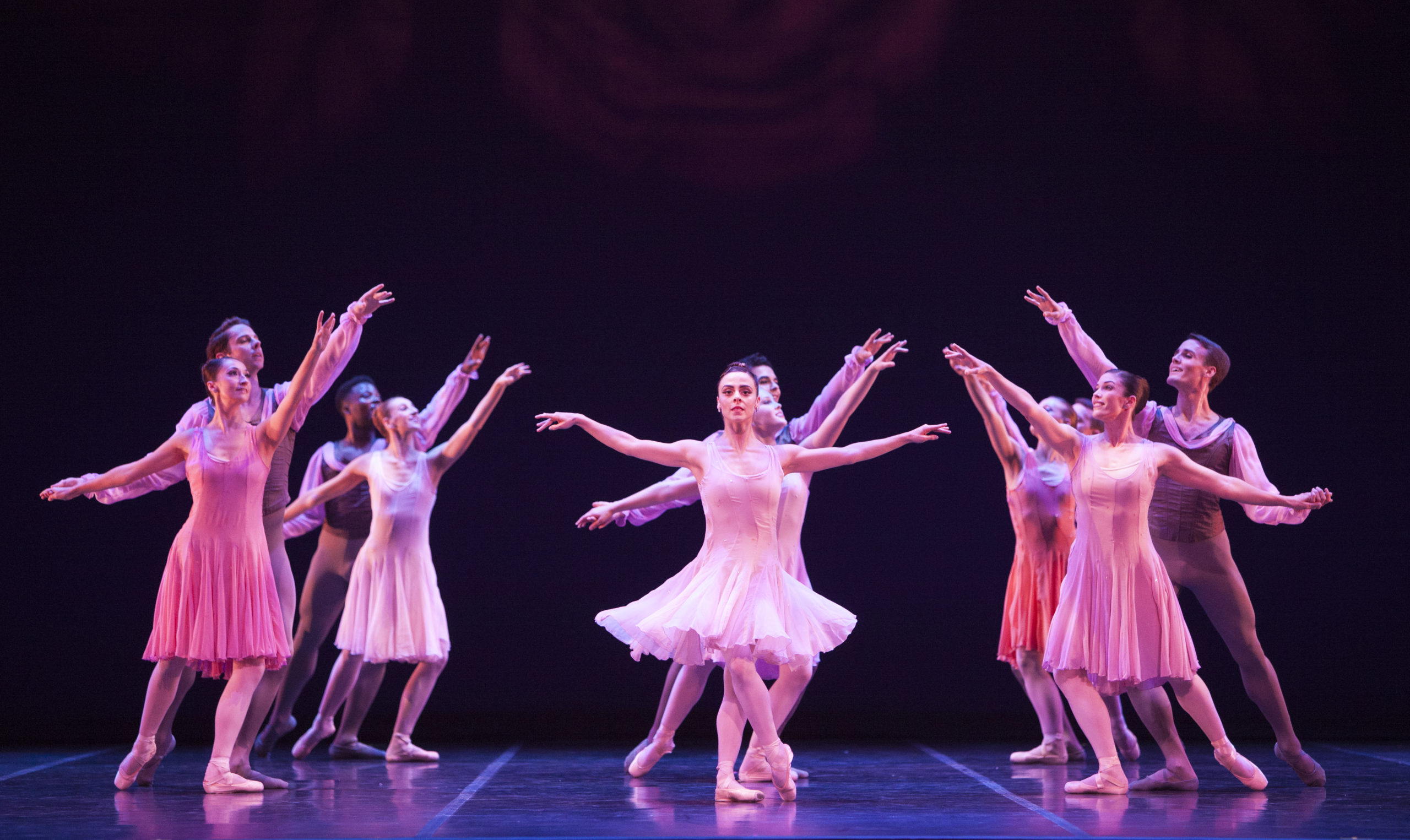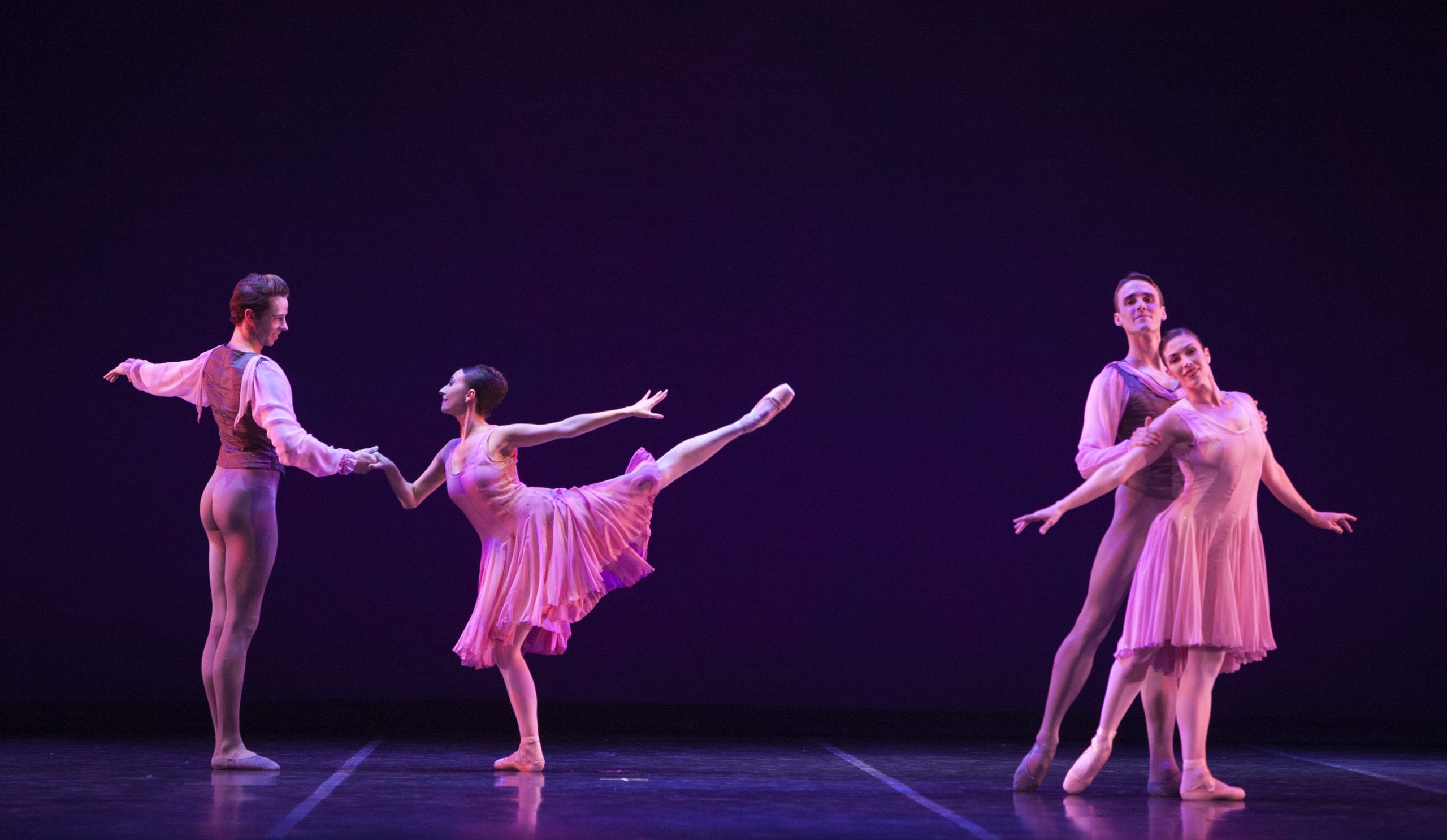Scroll down for details about BOUNCE & WOLFTANZT
Bounce & Wolftanzt
EXCLUSIVE VIDEO STREAMING OPPORTUNITY FOR TICKET HOLDERS | May 7-16, 2021
Artistic Director Stephen Mills selected BOUNCE & WOLFTANZT to highlight two of our esteemed Company dancers retiring at the close of this season: Jaime Lynn Witts and Brittany Strickland.
2021 Retirement Tribute
Lending their artistry to audiences in Austin and around the world, Jaime and Brittany enjoyed long careers with Ballet Austin for 20 and 14 years, respectively.
They each shared their shine with our audience, and we wish them both well and thank them for their grace and beauty on and off stage. Brava Jaime! Brava Brittany!
Click below to share a personal message with Jaime and Brittany.
Bounce
Stephen Mills’ eclectic and electrifying BOUNCE first premiered as one of three ballets in a collection of works known as TRUTH & BEAUTY / THE BACH PROJECT and then once more in THE GRAHAM REYNOLDS PROJECT. The production reunited Mills with frequent collaborator Graham Reynolds, who filled the piece with a unique sound comprised of and inspired by famed composer J.S. Bach. The Austinist hailed the world premiere as “…an emotionally charged and enjoyably challenging artistic collaboration driven by choreographer Stephen Mills.”
CHOREOGRAPHY: Stephen Mills
MUSIC: Graham Reynolds, after J.S. Bach
LIVE ACCOMPANIMENT: Graham Reynolds, with Live Accompaniment
Bounce runs 18 minutes.
Images by Tony Spielberg
Wolftanzt
Set to the beautifully composed “Piano Concerto #12 in A Major” by the renowned Wolfgang Amadeus Mozart, choreographer Stephen Mills’ WOLFTANZT first premiered as one of three ballets in a collection works known as THE MOZART PROJECT in 2011, followed by TO CHINA, WITH LOVE in 2016. WOLFTANZT was also a part of Ballet Austin’s 14-city tour of the People’s Republic of China in 2016. The Austin Chronicle applauded the world premiere for “…it’s impossible not to be influenced by Mozart, and purposefully delving into his mastery results in richness, illumination, a kind of collaboration.”
CHOREOGRAPHY: Stephen Mills
MUSIC: Wolfgang Amadeus Mozart
Wolftanzt runs 25 minutes.
Images by Anne Marie Bloodgood
Meet the Artists

STEPHEN MILLS
Choreography
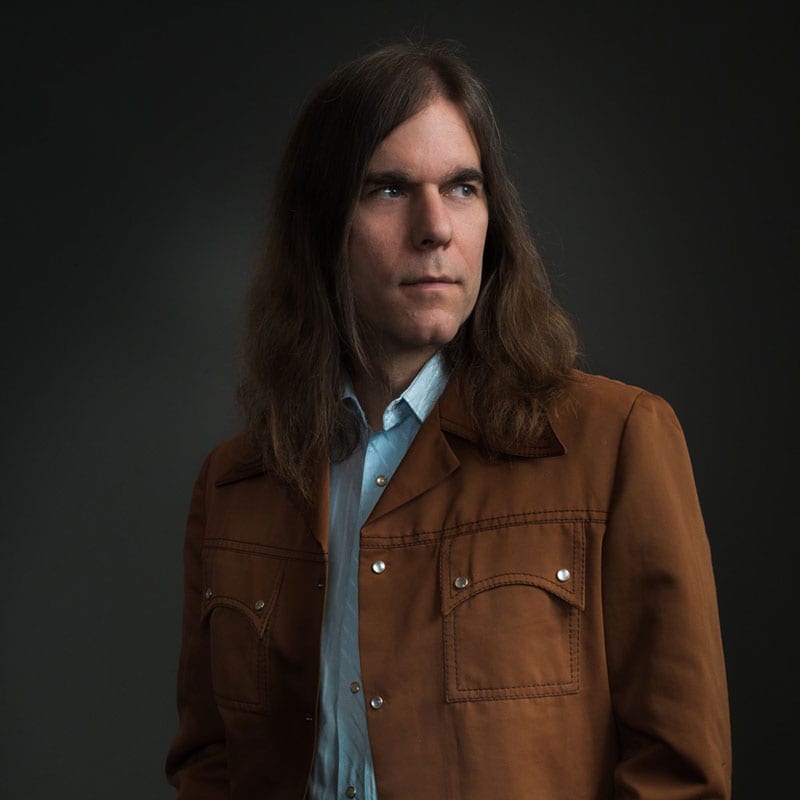
GRAHAM REYNOLDS
Music
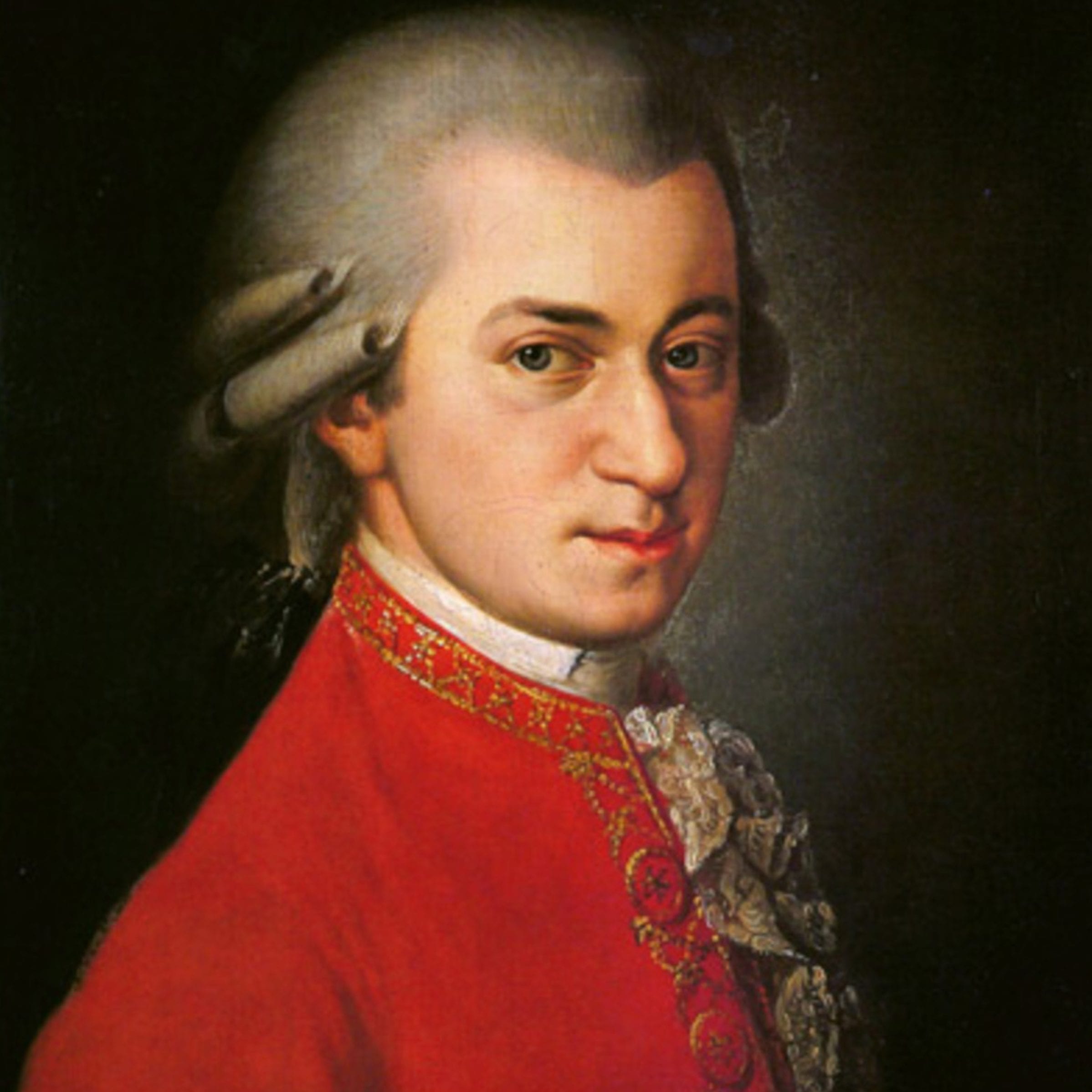
Wolfgang Amadeus Mozart
Music
More Information
Known for his innovative and collaborative choreographic projects, Stephen Mills has works in the repertoires of dance companies across the United States and worldwide.
His international career began in 1998 after being chosen Prix d’Auteur at les Rencontres Chorégraphiques Internationales de Seine-Saint-Denis in Paris. In his inaugural season as Artistic Director of Ballet Austin in 2000, Mills attracted national attention with Hamlet, hailed by Dance Magazine as “…sleek and sophisticated.”
Mills’ works showcased at The Kennedy Center include A Midsummer Night’s Dream, The Taming of the Shrew, and performances at the Ballet Across America Festival in collaboration with The Suzanne Farrell Ballet.
In 2005 Mills developed a community-wide human rights collaborative dialogue culminating in his signature work Light/The Holocaust & Humanity Project, for which he received the Audrey and Raymond Maislin Humanitarian Award from The Anti-Defamation League. Mills contributed a podcast about Light to the Voices on Anti-Semitism series at The United States Holocaust Memorial Museum and was invited to speak about the work at The United Nations in 2014. Light has been performed in five U.S. cities, in three cities in Israel, and was recently featured in an Emmy Award-winning PBS documentary, Sharing Light.
Called “the quintessential modern composer” by the London Independent, Austin-based composer-bandleader-improviser Graham Reynolds creates, performs, and records music for film, theater, dance, rock clubs, and concert halls with collaborators across a multitude of disciplines.
Heard throughout the world in films, TV, stage, and radio, he recently scored Richard Linklater’s Where’d You Go, Bernadette with Cate Blanchett, Kristen Wiig, and Laurence Fishburne for Annapurna Pictures, Happy Jail for Netflix, the Rude Mechs’ Stop Hitting Yourself for Lincoln Center Theater, Ballet Austin’s Grimm Tales, and a multi-year commission from Ballroom Marfa, The Marfa Triptych. He has performed on an array of legendary stages, from the Kennedy Center to the Green Mill Tavern to the Conan O’Brien Show. His Creative Capital Award winning project, Pancho Villa from a Safe Distance, a bilingual cross-border opera created with librettists Lagartijas Tiradas al Sol (Mexico City) and director Shawn Sides (Rude Mechs), has been staged in over a dozen cities in North America.
As Artistic Director of the non-profit Golden Hornet, he leads efforts which draw on the collaborative spirit of rock bands and the composer-led nature of classical music, with a focus on commissioning new music, fostering young and emerging composers, and presenting adventurous works in non-traditional settings. Alongside Kronos Quartet’s longtime cellist Jeffrey Zeigler, he curated The Sound of Science, an interdisciplinary, multimedia performance that is touring internationally.
Reynolds leads the jazz-based but far reaching Golden Arm Trio. He is a company member with the internationally acclaimed Rude Mechs theater collective and resident composer with Salvage Vanguard Theater and Forklift Danceworks. His accolades include a Creative Capital Award, an Independent Music Award, two Frederick R. Loewe Music Theatre Awards, ten Austin Critics Table Awards, the John Bustin Award, multiple Austin Chronicle Best Composer wins, and a B. Iden Payne Award. MARFA: A Country & Western Big Band Suite (Fall 2019) broke into the top 100 on the NACC radio charts along with a track premiere in Billboard. Graham recently signed with the London-based label Fire Records and his original score for Alfred Hitchcock’s silent classic, The Lodger, was released in October 2020 on their re-imagined soundtrack series.
Bio provided by grahamreynolds.com/bio
Piano
Graham Reynolds
Drum Set
Jeremy Bruch
Percussion/Marimba
Thomas Burritt
Percussion/Vibraphone
Chuck Fischer
Upright Bass
Utah Hamrick
Saxophone
John Mills
Trombone
Freddie Mendoza
Violin 1
Leah Zeger
Violin 2
Alexis Ebbets
Viola
Will Taylor
Cello
Hector Moreno
Engineer
Buzz Moran
Rehearsal Violinist
Maurice Chammah
A prolific artist, Austrian composer Wolfgang Mozart created a string of operas, concertos, symphonies and sonatas that profoundly shaped classical music.
Who Was Wolfgang Mozart?
Wolfgang Amadeus Mozart was a musician capable of playing multiple instruments who started playing in public at the age of 6. Over the years, Mozart aligned himself with a variety of European venues and patrons, composing hundreds of works that included sonatas, symphonies, masses, chamber music, concertos and operas, marked by vivid emotion and sophisticated textures.
Making it in Vienna
Back in Salzburg in 1779, Mozart produced a series of church works, including the Coronation Mass. He also composed another opera for Munich, Idomeneo in 1781. In March of that year, Mozart was summoned to Vienna by Archbishop von Colloredo, who was attending the accession of Joseph II to the Austrian throne. The Archbishop’s cool reception toward Mozart offended him. He was treated as a mere servant, quartered with the help, and forbidden from performing before the Emperor for a fee equal to half his yearly salary in Salzburg. A quarrel ensued and Mozart offered to resign his post. The Archbishop refused at first, but then relented with an abrupt dismissal and physical removal from the Archbishop’s presence. Mozart decided to settle in Vienna as a freelance performer and composer and for a time lived with friends at the home of Fridolin Weber.
Mozart quickly found work in Vienna, taking on pupils, writing music for publication, and playing in several concerts. He also began writing an opera Die Entführung aus dem Serail (The Abduction from the Seraglio). In the summer of 1781, it was rumored that Mozart was contemplating marriage to Fridolin Weber’s daughter, Constanze. Knowing his father would disapprove of the marriage and the interruption in his career, young Mozart quickly wrote his father denying any idea of marriage. But by December, he was asking for his father’s blessings. While it’s known that Leopold disapproved, what is not known is the discussion between father and son as Leopold’s letters were said to be destroyed by Constanze. However, later correspondence from Mozart indicated that he and his father disagreed considerably on this matter. He was in love with Constanze and the marriage was being strongly encouraged by her mother, so in some sense, he felt committed. The couple was finally married on August 4, 1782. In the meantime, Leopold did finally consent to the marriage. Constanze and Mozart had six children, though only two survived infancy, Karl Thomas and Franz Xaver.
As 1782 turned to 1783, Mozart became enthralled with the work of Bach and George Frederic Handel and this, in turn, resulted in several compositions in the Baroque style and influenced much of his later compositions, such as passages in Die Zauberflote (The Magic Flute) and the finale of Symphony Number 41. During this time, Mozart met Joseph Haydn and the two composers became admiring friends. When Haydn visited Vienna, they sometimes performed impromptu concerts with string quartets. Between 1782 and 1785 Mozart wrote six quartets dedicated to Haydn.
European Fame
The opera Die Entführung enjoyed immediate and continuing success and bolstered Mozart’s name and talent throughout Europe. With the substantial returns from concerts and publishing, he and Constanze enjoyed a lavish lifestyle. They lived in one of the more exclusive apartment buildings of Vienna, sent their son, Karl Thomas, to an expensive boarding school, kept servants, and maintained a busy social life. In 1783, Mozart and Constanze traveled to Salzburg to visit his father and sister. The visit was somewhat cool, as Leopold was still a reluctant father-in-law and Nannerl was a dutiful daughter. But the stay promoted Mozart to begin writing a mass in C Minor, of which only the first two sections, “Kyrie” and “Gloria,” were completed. In 1784, Mozart became a Freemason, a fraternal order focused on charitable work, moral uprightness, and the development of fraternal friendship. Mozart was well regarded in the Freemason community, attending meetings and being involved in various functions. Freemasonry also became a strong influence in Mozart’s music.
From 1782 to 1785, Mozart divided his time between self-produced concerts as soloist, presenting three to four new piano concertos in each season. Theater space for rent in Vienna was sometimes hard to come by, so Mozart booked himself in unconventional venues such as large rooms in apartment buildings and ballrooms of expensive restaurants. The year 1784, proved the most prolific in Mozart’s performance life. During one five-week period, he appeared in 22 concerts, including five he produced and performed as the soloist. In a typical concert, he would play a selection of existing and improvisational pieces and his various piano concertos. Other times he would conduct performances of his symphonies. The concerts were very well attended as Mozart enjoyed a unique connection with his audiences who were, in the words of Mozart biographer Maynard Solomon, “given the opportunity of witnessing the transformation and perfection of a major musical genre.” During this time, Mozart also began to keep a catalog of his own music, perhaps indicating an awareness of his place in musical history.
By the mid-1780s, Wolfgang and Constanze Mozart’s extravagant lifestyle was beginning to take its toll. Despite his success as a pianist and composer, Mozart was falling into serious financial difficulties. Mozart associated himself with aristocratic Europeans and felt he should live like one. He figured that the best way to attain a more stable and lucrative income would be through court appointment. However, this wouldn’t be easy with the court’s musical preference bent toward Italian composers and the influence of Kapellmeister Antonio Salieri. Mozart’s relationship with Salieri has been the subject of speculation and legend. Letters written between Mozart and his father, Leopold, indicate that the two felt a rivalry for and mistrust of the Italian musicians in general and Salieri in particular. Decades after Mozart’s death, rumors spread that Salieri had poisoned him. This rumor was made famous in 20th-century playwright Peter Shaffer’s Amadeus and in the 1984 film of the same name by director Milos Foreman. But in truth, there is no basis for this speculation. Though both composers were often in contention for the same job and public attention, there is little evidence that their relationship was anything beyond a typical professional rivalry. Both admired each other’s work and at one point even collaborated on a cantata for voice and piano called Per la recuperate salute di Ophelia.
Biographical excerpts courtesy of biography.com
Ashley Lynn Sherman
Anne Marie Melendez
Kirby Wallis
Jaime Lynn Witts
Paul Michael Bloodgood
Orlando Julius Canova
Edward Carr
Frank Shott
Oren Porterfield
Aara Krumpe/James Fuller
Brittany Strickland/Christopher Swaim
Constance Doyle
Courtney Holland
Elise Pekarek
Chelsea Marie Renner
Cassia Wilson
Ian J. Bethany
Orlando Julius Canova
Julian Goodwin-Ferris
Jordan Moser
Preston Andrew Patterson
JAIME LYNN WITTS
BA Trainee: 2001–2003 | BAII: 2003–2004 | Joined Company: 2004
Jaime Lynn Witts is originally from Bucks County, Penn., where she received most of her training from Maxim Ponomarenko, Oleg Briansky, and Mireille Briane. She attended summer programs at CPYB, Boston Ballet, and Ballet Austin. There, she continued her studies with Truman Finney in Ballet Austin’s Trainee program before joining Ballet Austin II. Since joining the company, Witts has performed in works by numerous choreographers including Stephen Mills, Thaddeus Davis, KT Nelson, Nicolo Fonte, Sidra Bell, Viktor Kabaniaev, Nelly van Bommel, Loni Landon, Jennifer Hart, Annabelle Lopez Ochoa, Gabrielle Lamb and Gina Patterson. She has enjoyed performing principal roles in George Balanchine’s Allegro Brillante and Agon,Swanhilda in Coppelia, Lilac Fairy in The Sleeping Beauty and Kate in The Taming of the Shrew, for which she earned her second Austin Critics Table Award. Most recently she has made her premier as the title role in Mills’ The Firebird. Witts has also had the honor of performing the role of The Survivor in Mills’ Light / The Holocaust & Humanity Project in Austin and on tour in Miami and Israel. When she is not dancing, Witts enjoys spending her time off with her daughter, Evaline.
BRITTANY STRICKLAND
BA Trainee: 2007–2008 | BAII: 2008–2010 | Joined Company: 2010
Brittany Strickland is originally from Winston-Salem, N.C. She attended the North Carolina School of the Arts (now the University of NCSA) from 2001-2007 where she trained under Melissa Hayden, Nina Danilova, and Kee-Juan Han. With NCSA, Brittany was privileged to perform George Balanchine’s Serenade at the Hollywood Bowl as well as performing featured roles in The Nutcracker, La Fille mal Gardee, La Sonnambula and Jardin Anime. Following graduation she continued her training with Ballet Austin under full scholarship. With Ballet Austin II she was privileged to perform featured roles in works such as Thang Dao’s Quiet Imprint and Stephen Mills’ Touch as well as performing with the company in Mills’ Coppelia and his world premiere of The Firebird. Since joining the company, she has enjoyed performing in works such as Mills’ The Taming of the Shrew, The Nutcracker, Carmina Burana, and Light / The Holocaust & Humanity Project. In her free time, Brittany also teaches in the Butler Center for Dance & Fitness.
THANK YOU TO OUR SPONSORS

Production Underwriter

Production Sponsor
Production Sponsor

Production Sponsor

Production Sponsor

Production Sponsor

